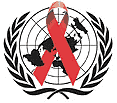February 7

My senior year of high school: As my uncle lay dying of AIDS in the hospital, a classmate of mine explained to our AP psychology class that God had created AIDS to punish gay people.
I didn’t say anything. My uncle was gay, and I was afraid that would only cement his point.
It’s 17 years later. Apparently, God didn’t know when to quit.
He punished homosexuals and heterosexuals, Blacks and Whites, Latinos, Asians, Native Americans and First Nations, men and women, the poor, and of course sub-Saharan Africa, perhaps because he felt he hadn’t given that continent enough to contend with already.
HIV/AIDS is neither racist nor sexist. It is an equal-opportunity infector, with only one preference: that its host live long enough to infect others.
Still, in 2004, men accounted for nearly three-quarters of all new HIV/AIDS cases in the United States, and African-Americans—who make only 12% of the general population—accounted for half of all new cases.
The spread of HIV/AIDS in Africa and among African-Americans led to other rumors about AIDS: not that it was sent by God to punish gays, but that it was invented by the government to use against Blacks.
The persistence (or truth-resistance) of rumors like these underlies a mystery that medical doctors and scientists haven’t explained. Ever since its youth in the early 1980’s, HIV/AIDS has displayed an uncanny ability to play upon the fears and prejudices of America with the expertise of a 1930’s dictator rising to power.
By taking root in the ‘Out’ caste in America (The mysterious killer was once called ‘Gay Cancer’), it ensured that serious government effort to stop or study the virus would be postponed for years, that millions of future hosts would be stigmatized, and that open dialogue about the disease would be nearly impossible.
The problem worsened as AIDS took hold in minority communities, where negative feelings about homosexuality ran even deeper than in society at large:
“Today, while there are black men who are openly gay, it seems that the majority of those having sex with men still lead secret lives, products of a black culture that deems masculinity and fatherhood as a black man’s primary responsibility — and homosexuality as a white man’s perversion.”
Men in heterosexual relationships who secretly have sex with other men are said to be on the “down low”. According to Ruth Houston:
“Record numbers of Black women are contracting HIV/AIDS through heterosexual contact – mainly from husbands and boyfriends on the down low…Many of us have been mistakenly led to believe we can tell a “down low brother” by his outward appearance or mannerisms – the way he walks, talks, dresses, or acts. As a result, many innocent Black men have been falsely accused.”
Black AIDS Day: A Wake-up Call for Black Women About the Down Low
But Keith Boykin, a former White House aide, believes the role of Down Low men has been overplayed:
“The down low…provided a sexy new vehicle to drive home a more predictable message about AIDS in the black community. With hints of closeted sexuality and talk of double lives, it played right into our stereotypical image of black men, and it conjured up the secrecy of a mysterious underground lifestyle.”
Beyond the Down Low, 2005
The same year that I was told that God had sent AIDS to punish gays, another classmate, an African-American bound for Princeton, argued in class that homosexuality was a Western phenomenon that didn’t exist in Africa. Even more confusing was my teacher’s response in evidence that it did: “What are you talking about? AIDS is rampant in Africa!”
If God did create AIDS, perhaps he did so, not to punish the marginalized, but to test the rest of us. We didn’t fail the test completely, but we haven’t passed with marks to write home about.
We have invested billions in AIDS research, developed miracle medicines that were unimaginable only a decade ago. But even this has shined a gloomy light on another human flaw.
Because of miracle technology, some of the uninfected continue to live their lives as if HIV/AIDS is no longer a fatal disease, [“If we change our lifestyles, the Viruses have won!“?] expecting that, worst case scenario, science will be there to bail them out.
A Peace Corps volunteer tells the story of how, at the end of her two years, the water pump broke in her small rural village. The villagers expected her to fix it. When she told them she thought they should fix it, that it would benefit the whole village to do so, they “laughed and said they would just wait for the next volunteer to come” and ask them. These formerly self-sufficient villagers had grown, not just to expect foreign aid, but to rely upon it.
Have we become a culture of dependency, confident that science will bail us out of the next mess?
AIDS has a remarkable power to adapt and reinvent itself, both chemically and politically. There is still no cure for the disease, and the drugs that now allow some Westerners to live with HIV are still wildly unaffordable for millions dying in Africa and the Third World.
Working in the field of drug and alcohol addiction in Los Angeles, I found that the “War on HIV/AIDS” is not so much a war as an endless series of battles that are fought through guerrilla tactics, by ordinary men and women on every street and in every house in cities across the continent.
And that miracle drugs are not the shields of the soldiers. They are band-aids for the wounded. The weapon is responsibility.
Every 10 seconds, someone on the planet dies of AIDS. More than 8,000 people will die today from this disease.
Make no mistake about it, the cavalry will not come to save us…
You see, we are the cavalry.






